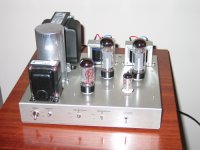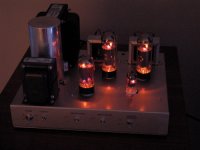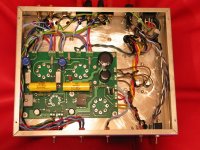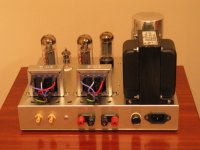G'Day All,
Have just finished construction of a Tubelab SimpleSE amplifier. Web site for the amp is here http://www.tubelab.com/SimpleSE.htm
George at TubeLab supplies the printed circuit boards for the amp and the information required to build the amp.
I have never owned or built a tube amp before and was looking to build an amp for my Lynn Olson Ariel speakers. I was looking to get an experience of building a tube amp without having to commit too much money, but also satisfy the competing criteria of a reasonable result.
The cct board supplied by George at Tubelab is well made and easy to populate. You have the option of mounting the larger components on the top or the bottom of the board depending on the mounting option you choose. I chose to mount the components on the back of the board so I could mount the board on the underside of the top of the chassis with the tube sockets protruding.
Power transformer is a Hammond 374BX 375-0-375 volt (I live in Australia with 240 volts)
Choke is a Hammond 193H 5H 200 ma
Output transformers Edcore XSE 15-8-5K ($19 each)
80 uF 500 volt motor run capacitor
JJ GZ 34 rectifier
JJ ECC81 (12 AT7) driver
JJ E 34 L output tubes
I have an active crossover at 80Hz with the low frequencies going to a solid state chip amp driving the woofer units recommended by Lynn Olson to accompany the Ariels, so George at Tubelab suggested that the low price Edcore output transformers would be good for my purpose (as well as being good value).
The build was straight forward. I put all of the components in a standard 12*10*2 Hammond aluminum chassis.
After triple checking my work (those high voltages scare me) and measuring the output voltages of the power transformer, I hooked up the amp in the basic triode mode, put a dummy load across the speaker terminals and plugged in a signal generator. Scope showed a clean output, so I hooked it up to my speakers and it worked.
After a couple of days I painted the chassis and hooked up the amp with all of the options: 80uF motor run cap, standby switch, valve (tube) rectification/solid state switch, triode/ultralinier switch, cathode feedback switch. All of those options makes for a bit of confusion and mass of wires in the chassis, but after double checking it all looked good and works.
As for hum, there is a little, but I have to have my ear just about in the speaker cone to hear it, so not a problem there.
As I have never owned a tube amp before, I cannot make any meaningful comparisons, however, I can say that I am very happy with the result, and am happy to have the amp as my main power amp (compared to home brew chip amp and adcom 555 power amps) on these speakers.
Have just finished construction of a Tubelab SimpleSE amplifier. Web site for the amp is here http://www.tubelab.com/SimpleSE.htm
George at TubeLab supplies the printed circuit boards for the amp and the information required to build the amp.
I have never owned or built a tube amp before and was looking to build an amp for my Lynn Olson Ariel speakers. I was looking to get an experience of building a tube amp without having to commit too much money, but also satisfy the competing criteria of a reasonable result.
The cct board supplied by George at Tubelab is well made and easy to populate. You have the option of mounting the larger components on the top or the bottom of the board depending on the mounting option you choose. I chose to mount the components on the back of the board so I could mount the board on the underside of the top of the chassis with the tube sockets protruding.
Power transformer is a Hammond 374BX 375-0-375 volt (I live in Australia with 240 volts)
Choke is a Hammond 193H 5H 200 ma
Output transformers Edcore XSE 15-8-5K ($19 each)
80 uF 500 volt motor run capacitor
JJ GZ 34 rectifier
JJ ECC81 (12 AT7) driver
JJ E 34 L output tubes
I have an active crossover at 80Hz with the low frequencies going to a solid state chip amp driving the woofer units recommended by Lynn Olson to accompany the Ariels, so George at Tubelab suggested that the low price Edcore output transformers would be good for my purpose (as well as being good value).
The build was straight forward. I put all of the components in a standard 12*10*2 Hammond aluminum chassis.
After triple checking my work (those high voltages scare me) and measuring the output voltages of the power transformer, I hooked up the amp in the basic triode mode, put a dummy load across the speaker terminals and plugged in a signal generator. Scope showed a clean output, so I hooked it up to my speakers and it worked.
After a couple of days I painted the chassis and hooked up the amp with all of the options: 80uF motor run cap, standby switch, valve (tube) rectification/solid state switch, triode/ultralinier switch, cathode feedback switch. All of those options makes for a bit of confusion and mass of wires in the chassis, but after double checking it all looked good and works.
As for hum, there is a little, but I have to have my ear just about in the speaker cone to hear it, so not a problem there.
As I have never owned a tube amp before, I cannot make any meaningful comparisons, however, I can say that I am very happy with the result, and am happy to have the amp as my main power amp (compared to home brew chip amp and adcom 555 power amps) on these speakers.
Attachments
Ha Ha Ha,
Does everyone catch the bug once they have had a successful project?
My kids think it is cool looking, so next project will be something for my son. He has a laptop with pretty crappy internal speakers, so was thinking of building a very cheap flea power amp with some matching cheap single driver speakers in small cabinets for desktop. Any suggestions?
Cheers!
Chris
Does everyone catch the bug once they have had a successful project?
My kids think it is cool looking, so next project will be something for my son. He has a laptop with pretty crappy internal speakers, so was thinking of building a very cheap flea power amp with some matching cheap single driver speakers in small cabinets for desktop. Any suggestions?
Cheers!
Chris
chrish said:Ha Ha Ha,
Does everyone catch the bug once they have had a successful project?
...
Chris
Yeah, you are pretty much a lost cause now.
Welcome valve amp building!

Nice pictures
"do you have any suggestion fore a cheap flea-amp" ...... well, you live in Australia, what other than "Spud-kit" fom Hawthorne
http://www.hawthorneaudio.com/catal..._id=16&zenid=1ec0b93e29729d044a13d6ac1bd5a4bb
Hell, I forgot that Hawthorne may be US/Canadian
"do you have any suggestion fore a cheap flea-amp" ...... well, you live in Australia, what other than "Spud-kit" fom Hawthorne
http://www.hawthorneaudio.com/catal..._id=16&zenid=1ec0b93e29729d044a13d6ac1bd5a4bb
Hell, I forgot that Hawthorne may be US/Canadian
Does everyone catch the bug once they have had a successful project?
Many people do! This is why you will see myself and others almost pleading with the newcommers not to start with an elaborate project that requries a large quantity of cubic dollars and runs on killovolts. The probability of success is much lower, and the cost of failure (emotional and monetary) is much higher.
As you found out a simple project that works the first time is rewarding and has the side effect of stirring the desire to build another one, often bigger.
I read your email and just replied. Thanks for the tips, they will be added to the manual.
As I stated in a previous thread on this forum, I will put your pictures in a "users amps" page on my web site. Anybody else have pictures of their Tubelab amps? Send them to me in an email, and I will post them.
chrish said:Ha Ha Ha,
My kids think it is cool looking, so next project will be something for my son. He has a laptop with pretty crappy internal speakers, so was thinking of building a very cheap flea power amp with some matching cheap single driver speakers in small cabinets for desktop. Any suggestions?
Chris
The Darling seems interesting for small power.
I built some bookshelf speakers using the Fostex FE-103 driver and they turned out really well. No bass to speak of but perfect for listening late at night when other people in the house are sleeping.
Look forward to seeing your next project(s)!
For the IEC cut out I carefully measured the dimensions required, transferred them to the chassis then used a nibbling tool to take out most of the waste, then used a small file, checking constantly for fit with the socket. I was pretty pleased it worked out OK. The Hammond chassis is pretty thin, so it is easy to work with. You will notice that I was careful to choose all other switches etc that used round mounting holes!
On a similar note, I punched the holes in the chassis with a set of punches from Harbour Freight. I picked up a set for $16 when I was in the US a couple of weeks ago. The smallest punch lasted for two holes before it chewed itself up, but the other punches seem to be OK.
Thanks for the amp and speaker suggestions so far!
Chris
On a similar note, I punched the holes in the chassis with a set of punches from Harbour Freight. I picked up a set for $16 when I was in the US a couple of weeks ago. The smallest punch lasted for two holes before it chewed itself up, but the other punches seem to be OK.
Thanks for the amp and speaker suggestions so far!
Chris
I have made the holes for the IEC connector by using a similar technique except that I used a Dremel tool with a cutoff wheel to make the initial (slightly too small) hole. I then used a small grinding stone in the Dremel and a file to finish the hole so that I could just pound the connector into the hole. I have used this method in thin aluminum like Hammond chassis and 1/8 inch channel (the Industrial amp).
My first set of cheap Harbor Freight punches self destructed in short order also. Then a friend showed me that I was using them incorrectly, so I got a second set. They are still alive after about 5 chassis, with plenty of life. The hole sizes are for electrical conduit, not tube sockets. The smallest one will make an acceptable hole for the 9 pin tube sockets (slightly too big).
Blue glow on the glass in power tubes is OK and somewhat common. Blue glow in between the elements of the tube was considered to be a sign of a gassy tube back in the 60's and 70's. Many tubes manufactured today seem to exhibit this glow, and it doesn't seem to be an issue. I have noticed that NOS tubes from the 60's do not glow in the same amp. I have some Electro Harmonix KT88's in my Industrial amp that put on a virtual light show with blue glow that dances to the music, both on the glass and internal to the elements. All 8 of the the tubes do it. I have run these as hard as 100 mA (which really heats up the power transformer). If you turn off all of the room lights and crank up something with a lot of bass you get a cool light show.
My first set of cheap Harbor Freight punches self destructed in short order also. Then a friend showed me that I was using them incorrectly, so I got a second set. They are still alive after about 5 chassis, with plenty of life. The hole sizes are for electrical conduit, not tube sockets. The smallest one will make an acceptable hole for the 9 pin tube sockets (slightly too big).
Blue glow on the glass in power tubes is OK and somewhat common. Blue glow in between the elements of the tube was considered to be a sign of a gassy tube back in the 60's and 70's. Many tubes manufactured today seem to exhibit this glow, and it doesn't seem to be an issue. I have noticed that NOS tubes from the 60's do not glow in the same amp. I have some Electro Harmonix KT88's in my Industrial amp that put on a virtual light show with blue glow that dances to the music, both on the glass and internal to the elements. All 8 of the the tubes do it. I have run these as hard as 100 mA (which really heats up the power transformer). If you turn off all of the room lights and crank up something with a lot of bass you get a cool light show.
Speaking of Power Transformers getting hot
Tubelab, I wanted to ask you about your Beloved Allied 6K7VG. I am working on Triode Dick's MonoBill, which requires pushing two KT88s full tilt, can the 6K7VG take this?
I want to use these for the Monoblocks because Allied has a pretty good name, and the price is certainly right $46.13
Sorry to threadjack...
-Moose
Tubelab, I wanted to ask you about your Beloved Allied 6K7VG. I am working on Triode Dick's MonoBill, which requires pushing two KT88s full tilt, can the 6K7VG take this?
I want to use these for the Monoblocks because Allied has a pretty good name, and the price is certainly right $46.13
Sorry to threadjack...
-Moose
I looked at the Mono Bill circuit and came to the conclusion that it would run 60 + 60 +20 mA at idle. 140 mA from a 175 mA (at 60 Hz) transformer is not bad. Now this is a class AB amp, so as soon as you turn up the volume, UP goes the current. This amp will easilly hit 250 mA on peaks. If you play simple music at a low volume level, no problem. If you put on some Pink Floyd and crank the volume to 11, the transformer will get hot. Will the transformer live? I have put these same transformers into guitar amps that run a pair of KT88's and get hammered very hard, and they don't blow up. If you do use the Allied transformer, keep the bias down near the recommended 60 mA per tube. Also, are you planning to run a tube rectifier? If so it eats another 10 to 15 watts of filament power, and adds heat to the chassis.
I have a bad habbit of turning things up. I am currently running a Simple SE with KT88's biased at about 100 mA, that is 100 + 100 + 10 + 10 mA, and the transformer does get HOT. So do the KT88's. I consider this an accelerated life test. I know somebody out there is going to do this and then complain if it blows up, so I am trying it first, but I don't recommend it. It hasn't blown up yet.
I will offer another suggestion. The 720 volt Antek toroid that is sold on Ebay has two seperate 360 volt windings and two seperate 6.3 volt windings. It has a 400VA rating, so it would smile at the load presented by both channels at the same time. If you are planning on using a common chassis you could run each channel on its own winding. You would need a small auxilliary transformer for the bias and CCS supplies. At $59 it is cheaper than two Allied transformers. I have powered two SimpleSE amps on one transformer without issue. It didn't even get warm. There is no 5 volt winding, so you almost have to use SS rectification.
http://cgi.ebay.com/720V-CT-360V-40...11199021QQihZ017QQcategoryZ4660QQcmdZViewItem
I have a bad habbit of turning things up. I am currently running a Simple SE with KT88's biased at about 100 mA, that is 100 + 100 + 10 + 10 mA, and the transformer does get HOT. So do the KT88's. I consider this an accelerated life test. I know somebody out there is going to do this and then complain if it blows up, so I am trying it first, but I don't recommend it. It hasn't blown up yet.
I will offer another suggestion. The 720 volt Antek toroid that is sold on Ebay has two seperate 360 volt windings and two seperate 6.3 volt windings. It has a 400VA rating, so it would smile at the load presented by both channels at the same time. If you are planning on using a common chassis you could run each channel on its own winding. You would need a small auxilliary transformer for the bias and CCS supplies. At $59 it is cheaper than two Allied transformers. I have powered two SimpleSE amps on one transformer without issue. It didn't even get warm. There is no 5 volt winding, so you almost have to use SS rectification.
http://cgi.ebay.com/720V-CT-360V-40...11199021QQihZ017QQcategoryZ4660QQcmdZViewItem
Thank you very much, This looks like a great transformer! This looks like the one for me, This will push 4 KT88s full tilt no problem at all.
The other secret is that I am really building 4 amps, for verticle bi-amping, but I wanted to see how much 2 amps costed first.
Looking at the numbers, this transformer should be able to push 8 KT88s full tilt....
I planned on using SS recitification,
Thank you so much Tubelab, this is exactly what I needed
The other secret is that I am really building 4 amps, for verticle bi-amping, but I wanted to see how much 2 amps costed first.
Looking at the numbers, this transformer should be able to push 8 KT88s full tilt....
I planned on using SS recitification,
Thank you so much Tubelab, this is exactly what I needed
chrish said:And the back end
chrish said:My kids think it is cool looking
Maybe it's just me, but with kids (or pets, or loved ones, or neighbors ...) around I'd put a cover on those output transformers. I see you heatshrinked the connectors, but I wouldn't bet my kids' lives on the quality of heatshrink.
I think this is the biggest downside of the Edcors.
- Status
- This old topic is closed. If you want to reopen this topic, contact a moderator using the "Report Post" button.
- Home
- More Vendors...
- Tubelab
- Tubelab SimpleSE



